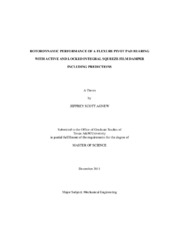| dc.description.abstract | Tests are performed on a flexure-pivot-pad tilting-pad bearing with a series integral squeeze film damper in load-between-pads configuration, with both active and locked damper. The damper effects are negated when locked, resulting in a flexure-pivot-pad bearing only. Experimental tests provide static performance data and dynamic stiffnesses from which rotordynamic coefficients are extracted. The following two excitation schemes are implemented: (1) multi-frequency, single direction excitation and (2) single-frequency, rotating load excitation (or "circular excitation"). The XLTRC2 Rotordynamics Software Suite provides stiffness and damping coefficient, eccentricity, and power loss predictions for the locked damper bearing. Test conditions include the rotor-speed range of 4000-12000 rpm and the unit-load range of 0-862 kPa (0-125 psi).
Dynamic tests utilizing the multi-frequency excitation for the locked and active damper bearing configurations both show that the real portion of the dynamic stiffness is well modeled by a quadratic curve fit, and the imaginary portion representing the damping is a linear function of excitation frequency. This means that frequency independent coefficients can be obtained when an added mass term is included. While stiffness coefficients are lower for the active damper bearing, damping coefficients remain almost constant between the locked and active damper configurations. A simulation shows that, although the damping coefficients do not change significantly, the reduced stiffness provided by the damper results in greater effective damping.
Static performance tests for the locked and active damper bearing indicate low cross-coupling, as shown by the eccentricity and low attitude angle measurements. Pad metal temperature measurements show a smaller temperature differential along the pad arcs for the active damper bearing, than observed for the locked damper case. Frictional power loss is estimated based on lubricant temperature rise and does not differ significantly for the two bearing configurations. | en |


